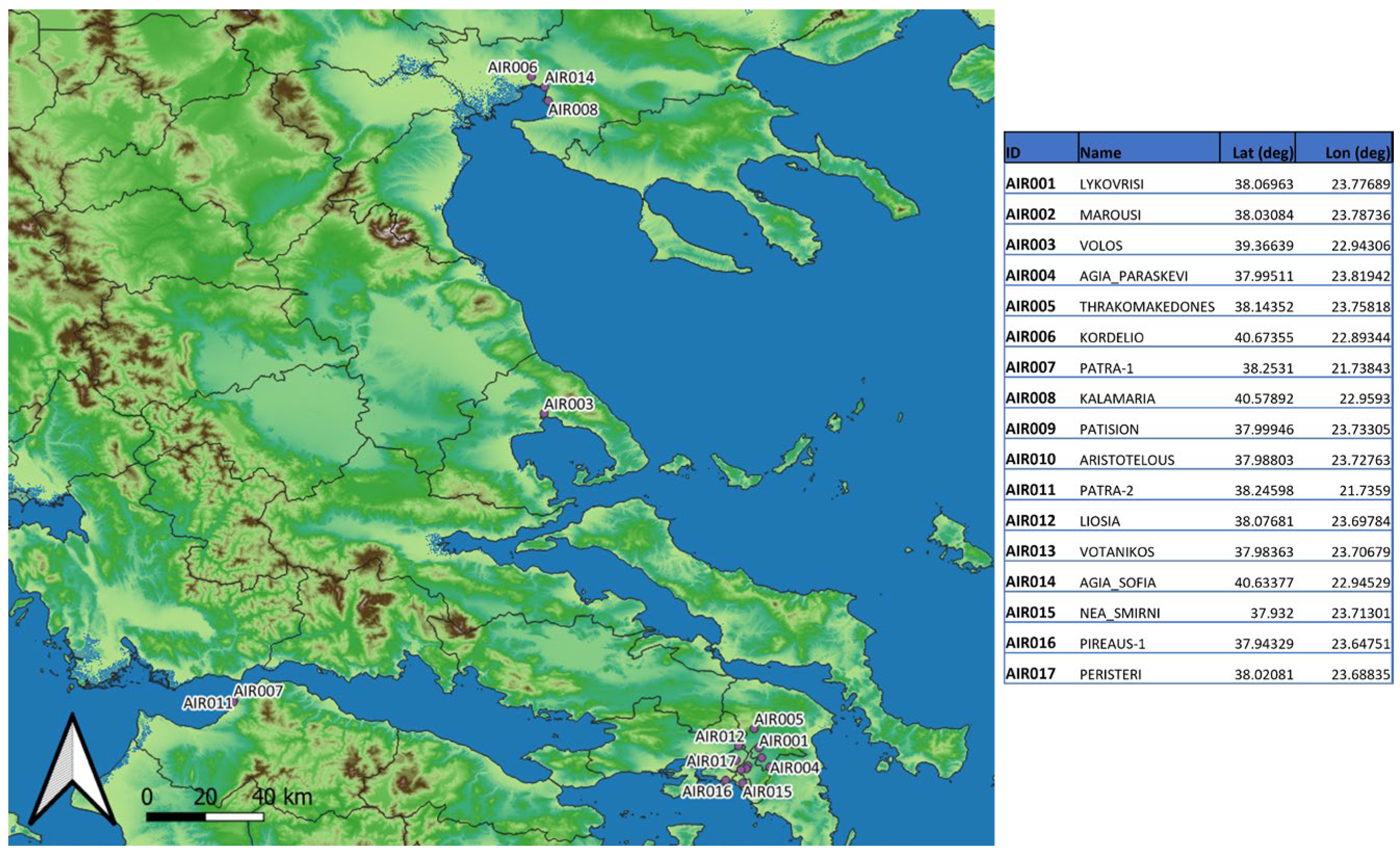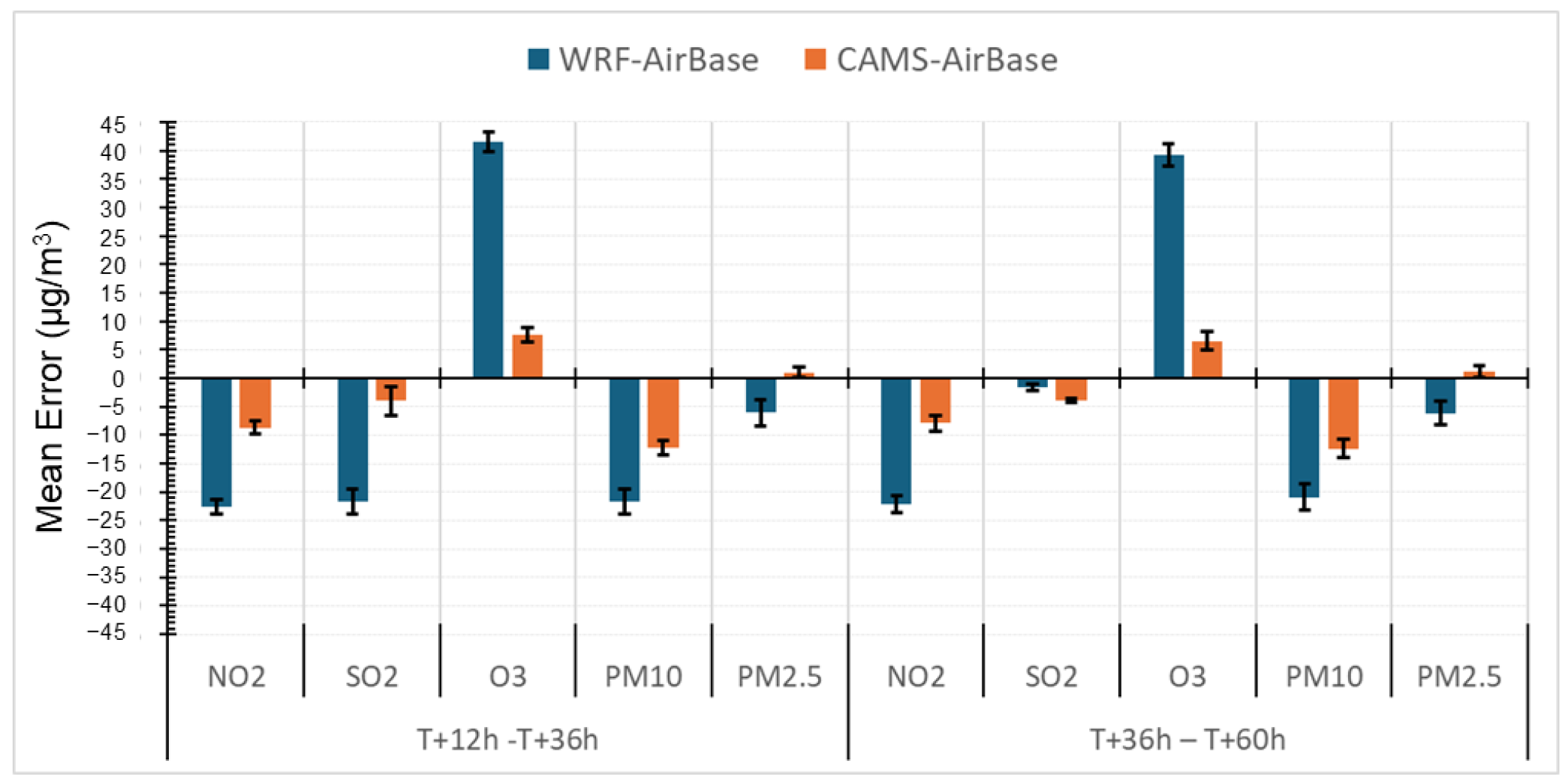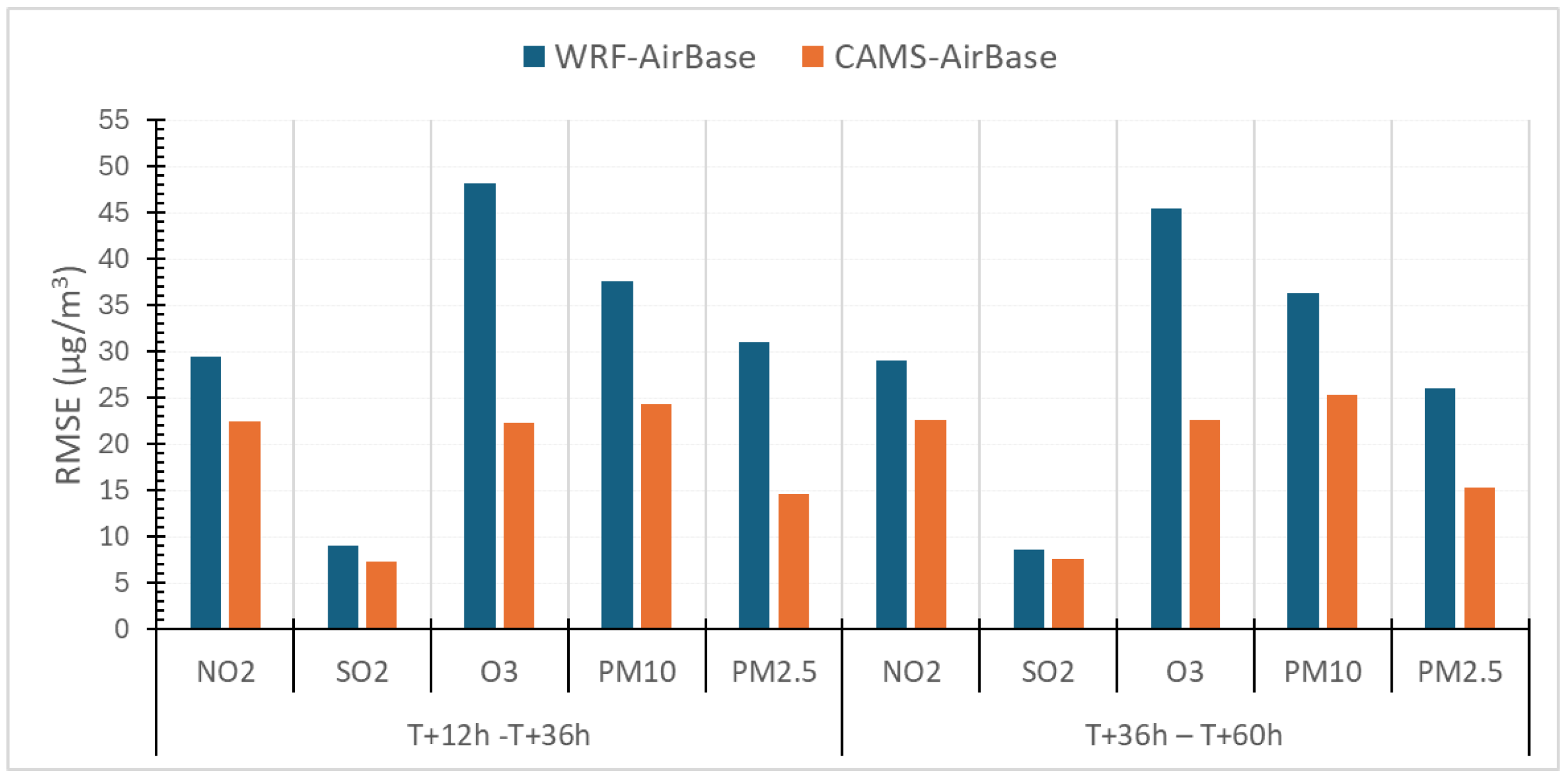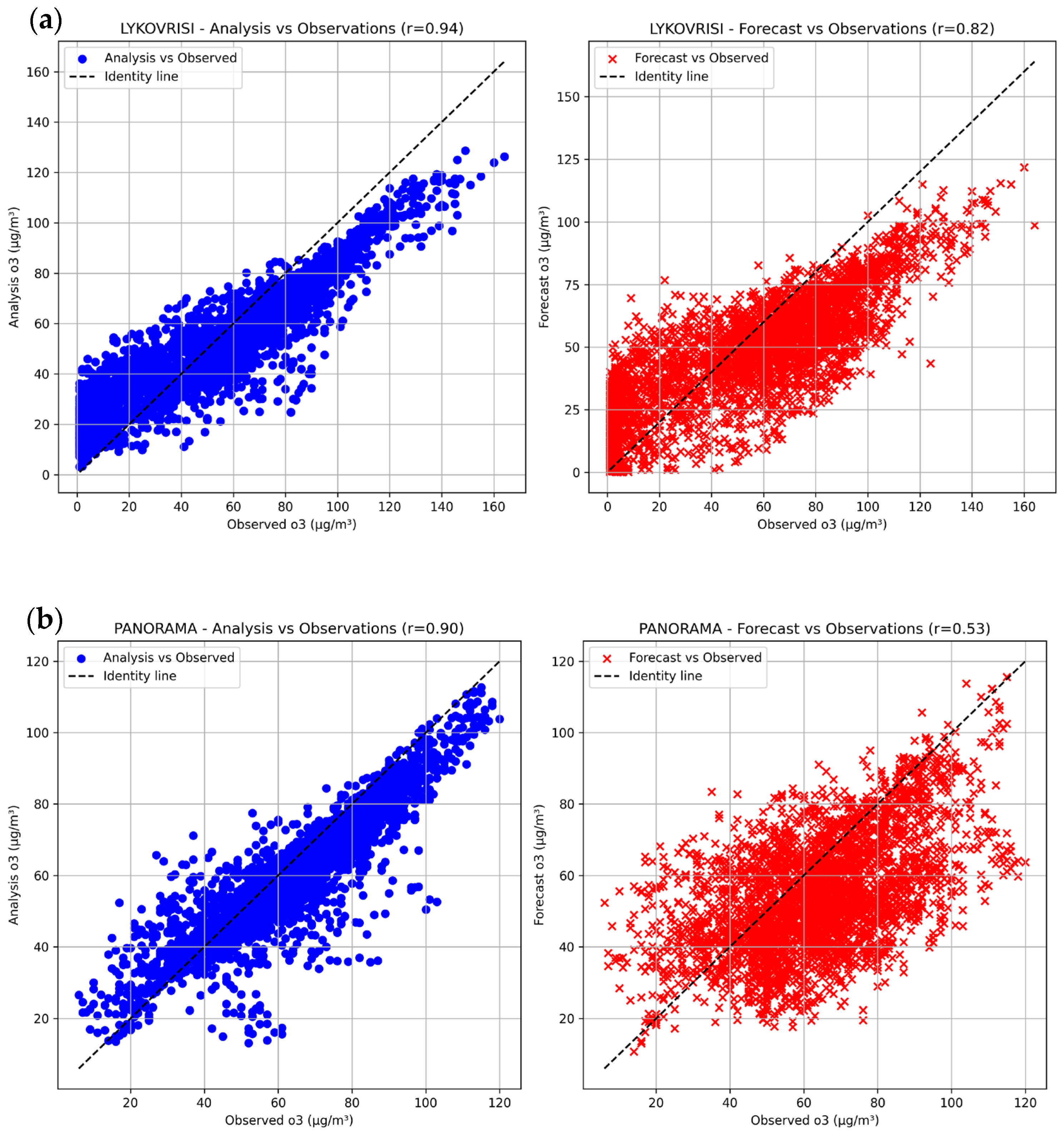AtmoHub: A National Atmospheric Composition Hub for Air Quality Monitoring and Forecasting in Greece †
Abstract
1. Introduction
2. Methodology
2.1. Air Quality Numerical Modelling Service
Species Mapping
2.2. Monitoring to In Situ Network
AIRBASE Stations Integration
2.3. CAMS Forecast Data Assessment
3. Results
3.1. Comparison of WRF-AtmoHub and CAMS Forecast Data Against AirBase Observations
3.1.1. Forecast Day 1 (T + 12 h − T + 36 h)
3.1.2. Forecast Day 2 (T + 36 h–T + 60 h)
3.2. Validation of the AtmoHub Monitoring-to-In Situ Network
4. Conclusions
Author Contributions
Funding
Institutional Review Board Statement
Informed Consent Statement
Data Availability Statement
Acknowledgments
Conflicts of Interest
References
- EEA. Greece—Air Pollution Country Fact Sheet 2024; EEA: Copenhagen, Denmark, 2024. [Google Scholar]
- Marinou, E.; Amiridis, V.; Binietoglou, I.; Tsikerdekis, A.; Solomos, S.; Proestakis, E.; Konsta, D.; Papagiannopoulos, N.; Tsekeri, A.; Vlastou, G.; et al. Three-Dimensional Evolution of Saharan Dust Transport towards Europe Based on a 9-Year EARLINET-Optimized CALIPSO Dataset. Atmos. Chem. Phys. 2017, 17, 5893–5919. [Google Scholar] [CrossRef]
- Lelieveld, J.; Berresheim, H.; Borrmann, S.; Crutzen, P.J.; Dentener, F.J.; Fischer, H.; Feichter, J.; Flatau, P.J.; Heland, J.; Holzinger, R.; et al. Global Air Pollution Crossroads over the Mediterranean. Science 2002, 298, 794–799. [Google Scholar] [CrossRef] [PubMed]
- Solomos, S.; Amiridis, V.; Zanis, P.; Gerasopoulos, E.; Sofiou, F.I.; Herekakis, T.; Brioude, J.; Stohl, A.; Kahn, R.A.; Kontoes, C. Smoke Dispersion Modeling over Complex Terrain Using High Resolution Meteorological Data and Satellite Observations—The FireHub Platform. Atmos. Environ. 2015, 119, 348–361. [Google Scholar] [CrossRef]
- Paraskevopoulou, D.; Liakakou, E.; Gerasopoulos, E.; Mihalopoulos, N. Sources of Atmospheric Aerosol from Long-Term Measurements (5years) of Chemical Composition in Athens, Greece. Sci. Total Environ. 2015, 527–528, 165–178. [Google Scholar] [CrossRef] [PubMed]
- Raptis, I.-P.; Kazadzis, S.; Amiridis, V.; Gkikas, A.; Gerasopoulos, E.; Mihalopoulos, N. A Decade of Aerosol Optical Properties Measurements over Athens, Greece. Atmosphere 2020, 11, 154. [Google Scholar] [CrossRef]
- Skamarock, W.C.; Klemp, J.B.; Dudhia, J.; Gill, D.O.; Barker, D.M.; Duda, M.G.; Huang, X.-Y.; Wang, W.; Powers, J.G. A Description of the Advanced Research WRF Version 4; National Center for Atmospheric Research: Boulder, CO, USA, 2019. [Google Scholar]
- Grell, G.A.; Peckham, S.E.; Schmitz, R.; McKeen, S.A.; Frost, G.; Skamarock, W.C.; Eder, B. Fully Coupled “Online” Chemistry within the WRF Model. Atmos. Environ. 2005, 39, 6957–6975. [Google Scholar] [CrossRef]
- Janssens-Maenhout, G.; Crippa, M.; Guizzardi, D.; Dentener, F.; Muntean, M.; Pouliot, G.; Keating, T.; Zhang, Q.; Kurokawa, J.; Wankmüller, R.; et al. HTAP_v2.2: A Mosaic of Regional and Global Emission Grid Maps for 2008 and 2010 to Study Hemispheric Transport of Air Pollution. Atmos. Chem. Phys. 2015, 15, 11411–11432. [Google Scholar] [CrossRef]
- Guenther, A.B.; Jiang, X.; Heald, C.L.; Sakulyanontvittaya, T.; Duhl, T.; Emmons, L.K.; Wang, X. The Model of Emissions of Gases and Aerosols from Nature Version 2.1 (MEGAN2.1): An Extended and Updated Framework for Modeling Biogenic Emissions. Geosci. Model Dev. 2012, 5, 1471–1492. [Google Scholar] [CrossRef]
- Morrison, H.; Thompson, G.; Tatarskii, V. Impact of Cloud Microphysics on the Development of Trailing Stratiform Precipitation in a Simulated Squall Line: Comparison of One- and Two-Moment Schemes. Mon. Weather Rev. 2009, 137, 991–1007. [Google Scholar] [CrossRef]
- Iacono, M.J.; Delamere, J.S.; Mlawer, E.J.; Shephard, M.W.; Clough, S.A.; Collins, W.D. Radiative Forcing by Long-Lived Greenhouse Gases: Calculations with the AER Radiative Transfer Models. J. Geophys. Res. Atmos. 2008, 113, 2–9. [Google Scholar] [CrossRef]
- Hong, S.-Y.; Noh, Y.; Dudhia, J. A New Vertical Diffusion Package with an Explicit Treatment of Entrainment Processes. Mon. Weather Rev. 2006, 134, 2318–2341. [Google Scholar] [CrossRef]
- Jiménez, P.A.; Dudhia, J.; González-Rouco, J.F.; Navarro, J.; Montávez, J.P.; García-Bustamante, E. A Revised Scheme for the WRF Surface Layer Formulation. Mon. Weather Rev. 2012, 140, 898–918. [Google Scholar] [CrossRef]
- Grell, G.A.; Freitas, S.R. A Scale and Aerosol Aware Stochastic Convective Parameterization for Weather and Air Quality Modeling. Atmos. Chem. Phys. 2014, 14, 5233–5250. [Google Scholar] [CrossRef]





| Statistical Metric | Definition |
|---|---|
| Mean Error | |
| Root Mean Squared Error |
Disclaimer/Publisher’s Note: The statements, opinions and data contained in all publications are solely those of the individual author(s) and contributor(s) and not of MDPI and/or the editor(s). MDPI and/or the editor(s) disclaim responsibility for any injury to people or property resulting from any ideas, methods, instructions or products referred to in the content. |
© 2025 by the authors. Licensee MDPI, Basel, Switzerland. This article is an open access article distributed under the terms and conditions of the Creative Commons Attribution (CC BY) license (https://creativecommons.org/licenses/by/4.0/).
Share and Cite
Kampouri, A.; Kartsios, S.; Kourantos, T.; Tsichla, M.; Voudouri, K.A.; Gialitaki, A.; Georgiou, T.; Drakaki, E.; Mermigkas, M.; Spyrakos, V.; et al. AtmoHub: A National Atmospheric Composition Hub for Air Quality Monitoring and Forecasting in Greece. Environ. Earth Sci. Proc. 2025, 35, 36. https://doi.org/10.3390/eesp2025035036
Kampouri A, Kartsios S, Kourantos T, Tsichla M, Voudouri KA, Gialitaki A, Georgiou T, Drakaki E, Mermigkas M, Spyrakos V, et al. AtmoHub: A National Atmospheric Composition Hub for Air Quality Monitoring and Forecasting in Greece. Environmental and Earth Sciences Proceedings. 2025; 35(1):36. https://doi.org/10.3390/eesp2025035036
Chicago/Turabian StyleKampouri, Anna, Stergios Kartsios, Thanos Kourantos, Maria Tsichla, Kalliopi Artemis Voudouri, Anna Gialitaki, Thanasis Georgiou, Eleni Drakaki, Marios Mermigkas, Vassilis Spyrakos, and et al. 2025. "AtmoHub: A National Atmospheric Composition Hub for Air Quality Monitoring and Forecasting in Greece" Environmental and Earth Sciences Proceedings 35, no. 1: 36. https://doi.org/10.3390/eesp2025035036
APA StyleKampouri, A., Kartsios, S., Kourantos, T., Tsichla, M., Voudouri, K. A., Gialitaki, A., Georgiou, T., Drakaki, E., Mermigkas, M., Spyrakos, V., & Amiridis, V. (2025). AtmoHub: A National Atmospheric Composition Hub for Air Quality Monitoring and Forecasting in Greece. Environmental and Earth Sciences Proceedings, 35(1), 36. https://doi.org/10.3390/eesp2025035036







